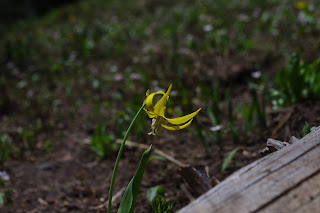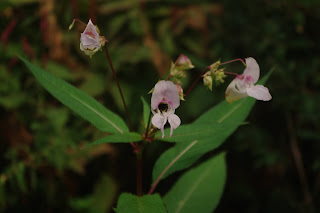A diary of back garden botany, urban ecology, rural rambles and field trips to the middle of nowhere...
Monday, 31 August 2020
A handful of dog's teeth. By which I mean Dog's Tooth Violet- the common name of species from the Erythronium genus. The tubers do bear a resemblance to the tooth of a canine and the European species is Erythronium dens-canis. The above are an American cultivar 'Pagoda' said to be a cross between E. tuolumnense and E. californicum 'White Beauty'.
Autumn is the time to plant spring flowering bulbs which is an exercise in visualising how an area might look in six months time. I already have a number of Pagodas in the garden:
Trout Lily seems to be the more usual common name in the States. I remember seeing a mountain meadow dotted with hundreds of Erythronium not far from Crater Lake in Oregon. They were daintier than 'Pagoda' but I'm not sure which species (possibly E. grandiflorum?). Dainty but tough; only a few weeks earlier the meadow would have been under deep snow...
Saturday, 29 August 2020
The Chiltern Hills came to mind on a rainy grey day in late August. I did several rambles round about midsummer to the Pegsdon Hills and Knocking Hoe on the Hertfordshire/ Bedfordshire border. Looking back at some of the photographs I remember how dry those rolling chalk hills were. And how alive the grasses and hedgerows were with a tapestry of flowers...
Thursday, 27 August 2020
Monday, 24 August 2020
Phacelia, Nasturtiums and Borage grow like mad on the allotment and I intend to make use of that quality in terms of how I approach things in the year ahead. Taking stock of what has done well this year and what hasn't it's very obvious that plants liking dry soil soil low in humus do just fine (Mediterranean herbs for example). On the other hand plants that crave a rich moist soil (e.g. Rhubarb) do not prosper.
So I'll apply the "right plant, right place" ethos to growing edibles. My plan is to use the aforementioned Phacelia, Nasturtiums and Borage as a groundcover across most if not all of the beds- they're self seeding freely anyway. I'll plant mainly perennials and let those annuals fill in the gaps. As the perennials grow and new ones are added I can thin out the groundcover accordingly.
Another strategy would be to buy a ton of compost, water constantly and wage a ceaseless war on weeds. In this way I might achieve a rectangle of bare earth intersected with neat rows of veg but to be honest that's not really what I want.
Sunday, 23 August 2020
Every year a mass of greenery envelopes the back porch at my father's house. A grape vine is completely entangled with a Chocolate Vine and both merge with a Virginia Creeper that grows up the side of the house. After the leaves drop in autumn I have to cut them back considerably to keep them in check. By that point in the year they are heading for the roof and smothering everything in the vicinity.
The habit of the climber is sometimes described as "feet in the shade, head in the sun". That is why climbers climb: to make for the sun. In their natural habitat they would be clambering trees or scrambling gorges. As it happens the walls of this Victorian house allow them to do what comes naturally.
Bunches of grapes appear every year. They usually don't get beyond being green and sour. In recent years however the long, hot, dry summers have yielded some tasty black grapes, though small.
The birds think so too and have been pecking away at them. Likewise a large fig tree nearby. It seems like there have more birds munching on the figs and the grapes than ever before. Perhaps that is because the fruit is riper than usual. Or perhaps there are more birds? The nesting season coincided with the lockdown. When the machine stopped there may have been some unintended benefits for wildlife?
Saturday, 22 August 2020
Friday, 21 August 2020
Wednesday, 19 August 2020
Himalayan Balsam (Impatiens glandulifera) flowers in late summer.
The flowers are pretty in pink and attract bumblebees.
Case in point the black centre of the middle flower in the photograph above is in fact the backside of a bumblebee!
Himalayan Balsam is indeed from the Himalayas and was introduced to the UK by Victorian gardeners who appreciated its qualities as a tall, fast growing annual. However I. glandulifera is no longer appreciated to the extent that it is considered an invasive species by the Wildlife and Countryside Act with certain legal restrictions on its spread.
If you type its name into a search engine there is no shortage of material explaining how bad it is. But there is another point of view. I would commend to you a 15 minute radio program archived on the BBC website from series one of 'Mabey in the Wild' by the ever illuminating Richard Mabey. The program is entitled 'Indian Balsam' which is an alternate common name. He has some fascinating things to say about the past, present and future of this outlaw plant.
Monday, 17 August 2020
This is not a spectacular plant, you will probably need to click on the photo to enlarge it to see the tiny white flowers. It does however have a delightful name: Enchanter's Nightshade. The Latin name is Circaea lutetiana. Circe was an enchantress in Greek mythology.
It has spread through a damp shady border alongside the house where I have tried several groundcover plants which haven't flourished. And lo! As if by magic Enchanter's Nightshade has self-seeded from who knows where and done the trick.
Sunday, 16 August 2020
A project for the months ahead: to renovate this border at my father's house as a nursery bed for various shade loving plants. I'll aim to propagate them myself as much as possible plus buy any that fit the bill as and when I see them.
Case in point I picked these up at a local car boot sale. Three Wood Spurge (Euphorbia amygdaloides var. robbiae) and three little Bugles (Ajuga reptans) which look to be the wild species rather than one of the cultivars. Also a very healthy looking Rosemary (Rosmarinus officinalis) which I'll take to the allotment.
I always keep an eye out for home grown plants at such events. Inevitably some are a bit scraggy and scrawny but it's often possible to spot a good 'un in which case they tend to be more robust than the garden centre equivalent. And cheaper too- these came to £10.50 in total for 7 plants!
Saturday, 15 August 2020
This diary does not shy away from the more functional aspects of life in the garden. Readers will know that I am relentless in pursuit of the sublime but I do need to do some laundry from time to time.
So it was a minor inconvenience when the washing line came down. It had been tied to the branch of a Sumach tree (Rhus typhina), one of three growing next to each other. Ordinarily Sumachs are a shrubby, spindly species but some previous resident was in the habit of pollarding them which fattens the bough. I continued this practice every couple of years but one of them seemed to give up the ghost lately and went from the vertical to the horizontal taking the washing line with it.
Fortunately my flatmate Paul scavenged a length of treated timber and last weekend it was planted flagpole style, God Save the Queen. My upstairs neighbour Keith did most of the digging I'm happy to say as I had a couple of nasty blisters on my left hand from a mishap at work stripping glue with a heat gun.
It might seem that there is not much to say about digging a hole in the ground but for the gardener it can be very illuminating. A soil profile can be made by digging a square(ish) hole straight down. Two things struck me about this particular hole which was about 18"/50cm deep.
Firstly, the soil was bone dry all the way down- not a hint of dampness which indicates just how severe the drought has been. Secondly, the soil was loose and grainy from top to bottom which surprised me. Years ago I excavated an adjacent area for a small pond. About 12"/30cm down I got through the top soil and hit a layer of impenetrable clay. London Clay is known for its density.
It's difficult to be too precise about soil in back gardens because there has often been a considerable amount of disturbance. None the less I put this location into the British Geological Society's "My Soil" app. The soil at this address is described as Clayey Loam to Silty Loam. 50 paces south it is Clay to Silt, 50 paces north it is Silt to Silty Loam. Perhaps this very garden marks the borders of different bands of soil?
Anyway, we got the washing line up in time for the weather to turn wet...
Friday, 14 August 2020
The garden is both parched and green after weeks without rain. The summer has been hot and dry for the most part, the third in a row. The trees and shrubs provide the greenery and the foliage of some of the perennials also resists the drought. The spring flowering plants are generally gone to seed and well on the way to dying back.
Thankfully rain is forecast to break the heatwave of the past week, said to be the longest run of temperatures this high in London since 1961. Cool, damp days will be like balm for me. Much as I love the sun I find it easier to warm up in winter than I do to cool down in summer!
Tuesday, 11 August 2020
Vetches are scramblers, and there are a lot of them- in the region of 140 species around the world. This is probably Tufted Vetch (Vicia cracca)? It's classed as a native wildflower; then again it's widely sown as a forage crop, cover crop and green manure and these will have seeded back into the wild.
Friday, 7 August 2020
Yellow Loosestrife sounds like it must be a relative of Purple Loosestrife. In fact there are two plants commonly known as Yellow Loosestrife (Lysimachia vulgaris and Lysimachia punctata) and they are of the Primulaceae family. Purple Loosestrife (Lythrum salicaria) belongs to the Lythraceae family.
L. vulgaris is native to the UK whereas L. punctata is an introduction from south-east Europe and is sometimes referred to as Garden Loosestrife. They look very similar but the former has whorls of three flowers round the stem wheras the latter has four. Neither are as prolific and widespread as Purple Loosestrife.
I saw the stand above in Edale five or six years ago. Actually the stems are so flowery I'm not sure which Yellow Loosestrife it is!
Wednesday, 5 August 2020
Subscribe to:
Comments (Atom)







































